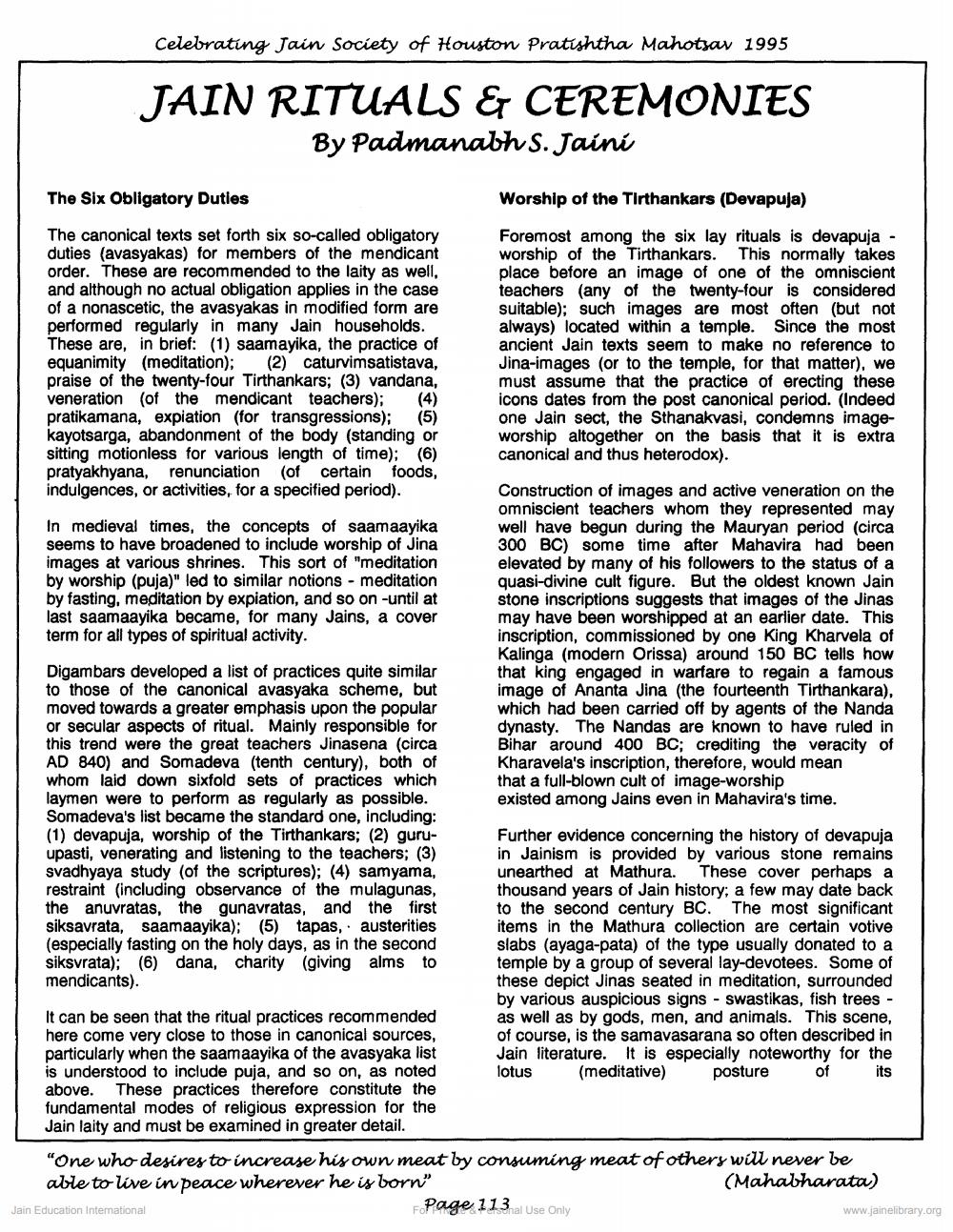________________
Celebrating Jain Society of Houston Pratishtha Mahotsav 1995
JAIN RITUALS & CEREMONIES
By Padmanabh S. Jaini
The Six Obligatory Duties
Worship of the Tirthankars (Devapuja)
The canonical texts set forth six so-called obligatory duties (avasyakas) for members of the mendicant order. These are recommended to the laity as well, and although no actual obligation applies in the case of a nonascetic, the avasyakas in modified form are performed regularly in many Jain households. These are, in brief: (1) saamayika, the practice of equanimity (meditation); (2) caturvimsatistava, praise of the twenty-four Tirthankars; (3) vandana, veneration (of the mendicant teachers); (4) pratikamana, expiation (for transgressions); (5) kayotsarga, abandonment of the body (standing or sitting motionless for various length of time); (6) pratyakhyana, renunciation (of certain foods, indulgences, or activities, for a specified period).
Foremost among the six lay rituals is devapuja - worship of the Tirthankars. This normally takes place before an image of one of the omniscient teachers (any of the twenty-four is considered suitable); such images are most often (but not always) located within a temple. Since the most ancient Jain texts seem to make no reference to Jina-images (or to the temple, for that matter), we must assume that the practice of erecting these icons dates from the post canonical period. (Indeed one Jain sect, the Sthanakvasi, condemns imageworship altogether on the basis that it is extra canonical and thus heterodox).
In medieval times, the concepts of saamaayika seems to have broadened to include worship of Jina images at various shrines. This sort of "meditation by worship (puja)" led to similar notions - meditation by fasting, meditation by expiation, and so on -until at last saamaayika became, for many Jains, a cover term for all types of spiritual activity.
Construction of images and active veneration on the omniscient teachers whom they represented may well have begun during the Mauryan period (circa 300 BC) some time after Mahavira had been elevated by many of his followers to the status of a quasi-divine cult figure. But the oldest known Jain stone inscriptions suggests that images of the Jinas may have been worshipped at an earlier date. This inscription, commissioned by one King Kharvela of Kalinga (modern Orissa) around 150 BC tells how that king engaged in warfare to regain a famous image of Ananta Jina (the fourteenth Tirthankara), which had been carried off by agents of the Nanda dynasty. The Nandas are known to have ruled in Bihar around 400 BC; crediting the veracity of Kharavela's inscription, therefore, would mean that a full-blown cult of image-worship existed among Jains even in Mahavira's time.
Digambars developed a list of practices quite similar to those of the canonical avasyaka scheme, but moved towards a greater emphasis upon the popular or secular aspects of ritual. Mainly responsible for this trend were the great teachers Jinasena (circa AD 840) and Somadeva (tenth century), both of whom laid down sixfold sets of practices which laymen were to perform as regularly as possible. Somadeva's list became the standard one, including: (1) devapuja, worship of the Tirthankars; (2) guruupasti, venerating and listening to the teachers; (3) svadhyaya study (of the scriptures); (4) samyama, restraint (including observance of the mulagunas. the anuvratas, the gunavratas, and the first siksavrata, saamaayika); (5) tapas, austerities (especially fasting on the holy days, as in the second siksvrata); (6) dana, charity (giving alms to mendicants).
Further evidence concerning the history of devapuja in Jainism is provided by various stone remains unearthed at Mathura. These cover perhaps a thousand years of Jain history; a few may date back to the second century BC. The most significant items in the Mathura collection are certain votive slabs (ayaga-pata) of the type usually donated to a temple by a group of several lay-devotees. Some of these depict Jinas seated in meditation, surrounded by various auspicious signs - Swastikas, fish trees - as well as by gods, men, and animals. This scene, of course, is the samavasarana so often described in Jain literature. It is especially noteworthy for the lotus (meditative) posture of its
It can be seen that the ritual practices recommended here come very close to those in canonical sources, particularly when the saamaayika of the avasyaka list is understood to include puja, and so on, as noted above. These practices therefore constitute the fundamental modes of religious expression for the Jain laity and must be examined in greater detail.
"One who desires to increase his own meat by consuming meat of others will never be able to live in peace wherever he is born"
(Mahabharata) Jain Education Intemational Page 113 al Use Only
www.jainelibrary.org




